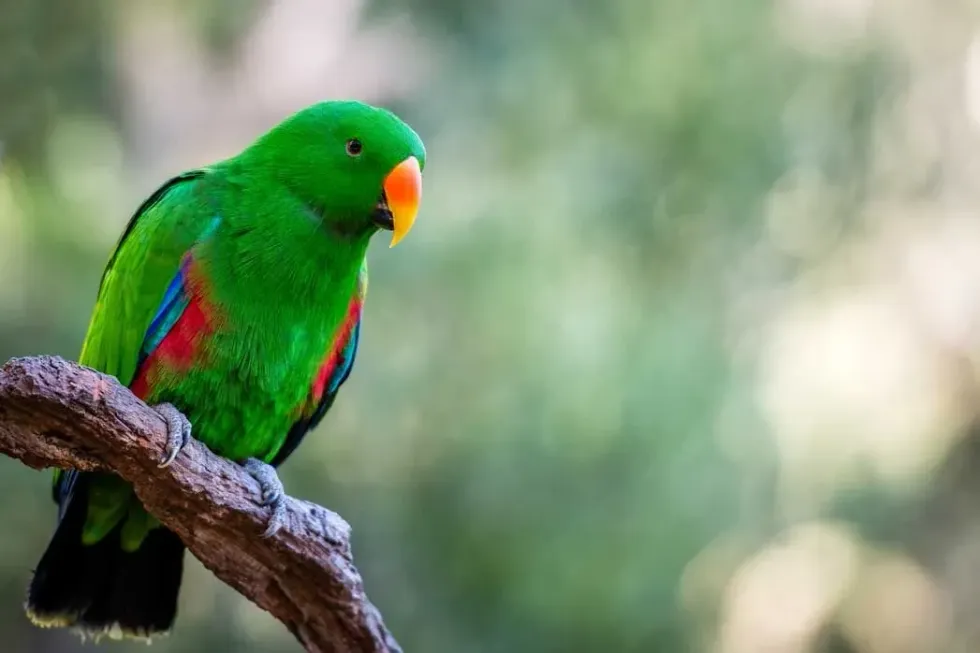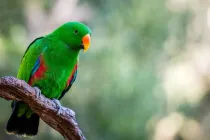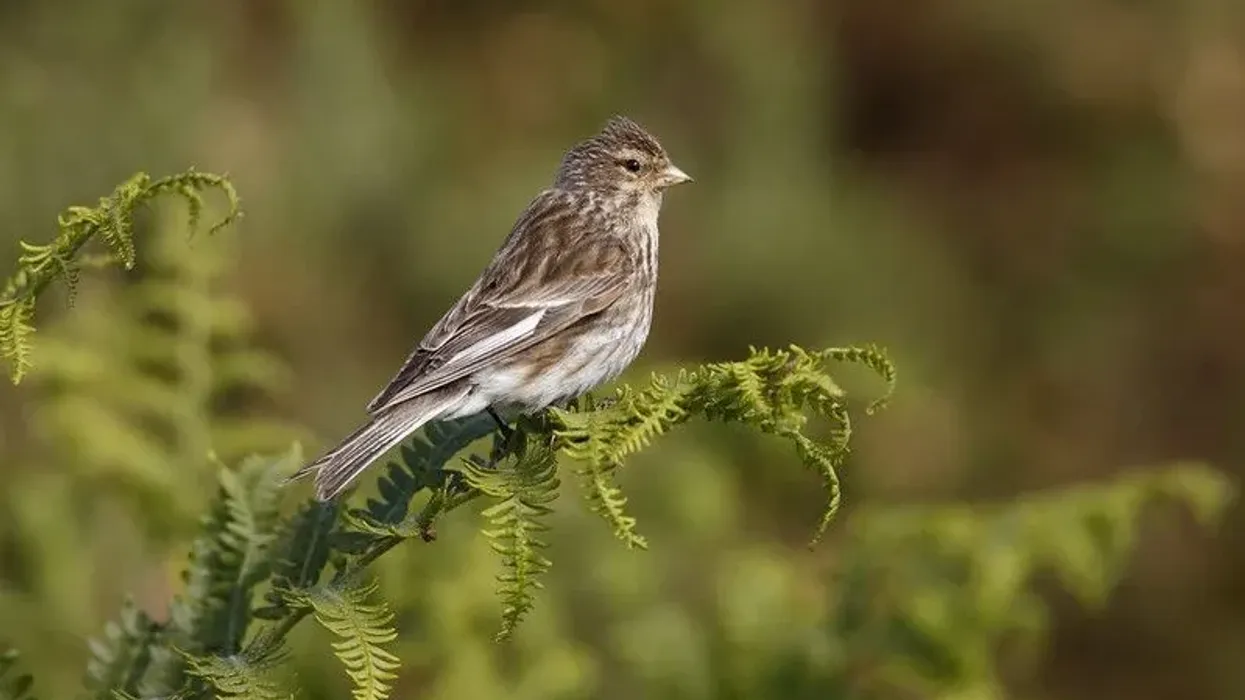The Eclectus parrot, Eclectus roratus species belonging to the family Psittacidae, are native to the Solomon Islands in the South Pacific. The Solomon Islands Eclectus parrot is also known by names like the grand Eclectus parrot, blue bellied Eclectus parrot, red-sided Eclectus parrot, yellow-sided Eclectus parrot, and dusky Eclectus parrot.
Several subspecies of these birds are found in Australia, Indonesia, Papua and New Guinea, and Palau.
Eclectus parrot pets are extremely popular due to their colorful looks, ease of maintenance, and affectionate temperament. Solomon Island Eclectus parrots are sexually dimorphic. That means the male and female birds have distinguishingly different physical characteristics.
Males of this avian species have brilliant green feathers and the female birds feature ruby red plumage. Males have red underwings and blue red markings on their underbelly and wings. The females may have blue-violet patches on their wings, neck, and underbelly.
These birds are diurnal feeders and start flying above the forest to forage with the first morning light. Calls of the Eclectus roratus are high pitched, loud, ear-shattering squeaks, and screeches. The soft feathers of these birds have an appearance similar to fur.
Read on to find out more. You may also check out the fact files on bee hummingbird and African pygmy goose from Kidadl.
Eclectus Parrot Interesting Facts
What type of animal is an Eclectus parrot?
All species of Eclectus parrots are brilliant birds that are probably the most colorful of all parrot birds species.
What class of animal does an Eclectus parrot belong to?
Eclectus parrots belong to the Aves family.
How many Eclectus parrots are there in the world?
It is difficult to tell the exact number of Eclectus parrots in the world. There are many subspecies of Eclectus roratus that live in the wild and as pets.
Right now, the Eclectus roratus is the only living species found from the Eclectus genus. Fossil records found in the islands of Tonga and Vanuatu suggest the presence of similar species of birds in the past. The oceanic Eclectus parrot (Eclectus infectus) bird fossils feature smaller wings and are now thought to be extinct.
Where does an Eclectus parrot live?
Eclectus parrots live in tropical rainforests in the wild. The large Eclectus parrots or Eclectus roratus inhabit the dense forests in Indonesia, Eastern Cape York Peninsula, ranging from the Pascoe River to Massey Creek, to McIlwraith range in Australia.
They are also common in the Solomon Islands, New Guinea, and the Moluccas. These emerald green and bright red male and female parrot species are also kept as pets.
What is an Eclectus parrot's habitat?
The noisy Eclectus parrots mostly occupy the canopy of rainforests. They are also found in nearby eucalypt woodlands, and tree clumps in savannahs.
Eclectus parrot information that pet owners require is that the ideal temperature for these birds is 70-80 F (21-27 C). This species of birds are generally healthy and can bear moderate hot and cold temperatures.
Who do Eclectus parrots live with?
In their wild habitat, species of the parrot (Eclectus) live in small flocks. They also often live in pairs. At the break of daylight, the flock of parrots looks for food. The availability of fruits often decides the size of the flock. At night Eclectus parrots may roost in large groups of up to 80 birds.
The Eclectus parrot's personality is agile and bold. It has a shrill, loud call. While foraging and flying, the parrots may make a ‘chu-wee’ sound and also make screeching noise when they fly.
Possums, birds of prey, and wild dogs are predators of this avian species.
How long does an Eclectus parrot live?
Eclectus parrot lifespan is 30-40 years in the wild and 50- 60 years in captivity.
How do they reproduce?
The ideal breeding time for Eclectus parrots is between July and January. The male green Eclectus parrot and the red Eclectus parrot female do not stay together as a mating pair for life and only come together during the breeding season.
The male and female Eclectus birds find new partners throughout their lives every breeding season. The courtship ritual involves is an exciting squawking sound by the Eclectus parrot male.
The sexual dimorphism of this species explains some of the breeding strategies of these birds. The polygamous birds look for mates in every season.
The vivid red plumage of the female birds helps the males to locate them in the forest as they fly through the nesting sites. Nests are typically in tree hollows. The ideal nesting trees are the ones that grow in a clearing or the edge of the wooded area.
The nests are lined with wood chips and the eggs are laid on them. Eclectus females usually lay two white eggs every season. After the eggs are laid they are incubated by the female Eclectus parrot.
The male brings food for the female to the nest. Both the parents are involved in the rearing of the baby Eclectus parrots.
Something is very interesting about their communal breeding culture in their wild habitat. Offspring from previous broods help in rearing the young.
The sharing and caring Eclectus parrot personality reflect when they are kept in homes as pets. When the chicks are born, their bodies are covered with short, thick bristles that gradually become grayish in three days. It is difficult to tell the gender of the bird unless it develops its bright green or red feather.
In about 11-12 weeks the chicks start to grow their feathers or fledge. These birds attain sexual maturity in two to three years.
What is their conservation status?
The range of the Eclectus roratus is large and the IUCN red list states their conservation status as Least Concern. Its population is, however, decreasing in the wild.
Eclectus Parrot Fun Facts
What do Eclectus parrots look like?
The most striking part about the appearance of Eclectus parrots is the eye-catching color of their plumage. The bright green feather of the males and the vivid red feathers of the female probably marks the most distinguished sexual dimorphism in the animal world.
Eclectus parrots are medium-sized birds measuring 17-20 in (43.1–50.8 cm) length. The males have emerald green feathers with scarlet plumage under their bellies and some hues of blue and red on the wings. Males have an orange upper beak and the lower mandible is grayish black.
These parrots have short square tails. The central tail feathers of the males are green-tipped with blue. The visible outer tail feathers are tipped with blue with white. The tail underside is tipped yellow markings. The feet and toes are gray.
The female birds have beautiful red plumage. The feathers grow darker on the back and wing plumage. They have a blue collar around their neck. The edge of the wings and the underwings are bright blues.
A violet-blue band runs across the belly. The short tail is red-tipped with yellow-orange. These colorful birds have a blue ring around their eyes. The bill is black and the feet are gray.

How cute are they?
The males are more affectionate. Due to their friendly, intelligent personality, this bird is a popular pet.
How do they communicate?
Eclectus parrots are good with children but do not like frantic activity or disturbing noise. These may trigger them to screech and squawk. They are vocal birds.
It is a common practice to teach Eclectus parrot talk. The Eclectus parrot talking capability makes it even more popular as a bird pet. These birds can learn an extensive list of words or sentences.
How big is an Eclectus parrot?
Eclectus parrots are two times smaller than the hyacinth macaw.
How fast can an Eclectus parrot fly?
Eclectus parrots can fly at an average speed of 40 mph (11.1 kph).
How much does an Eclectus parrot weigh?
An eclectus parrot weighs 0.97-2.2 lb (04.-0.99 kg).
What are the male and female names of the species?
Eclectus parrot male and female birds do not have any special names.
What would you call a baby Eclectus parrot?
A baby Eclectus parrot is called a chick, a nestling, or a fledgling.
What do they eat?
In the wild, the Eclectus parrot diet includes fruits, leaf buds, flowers, nectar, berries, seeds, grains. They love sweet fruits like papaya, pomegranate, figs.
In captivity, Eclectus parrot diets cover vitamin-rich seed mix, and fresh food is the ideal diet. Vegetables and many fruits can be included in the diet. Feeding an Eclectus parrot pet avocado or chocolate can be fatal as these are toxic foods for the birds.
Are they friendly?
Eclectus parrots are friendly and bond with owners.
Would they make a good pet?
Eclectus parrots are good pet birds. This species of birds are available in specialty avian pet shops and from breeders. The Eclectus parrot price may be $1500-$2500. The Eclectus parrot cost is high compared to many other birds as they are native to only a few countries and lay only two eggs every season.
Eclectus parrot mutations often create exotic-looking parrots with unique colorations that may be sold at hefty prices of up to $22,000. It is essential to take proper Eclectus parrot care or else the birds may face health issues.
Another important thing that Eclectus parrot owners should avoid is overfeeding the parrots with minerals and vitamins. These birds have a specialized digestive tract that differs from other avian species. This bird species requires a high fiber and low-fat diet or may face issues like digestive tumors. Feather plucking is often a sign of stress in captivity.
Did you know...
In New Guinea, the feathers of the Eclectus parrots are used as decorations by the native people.
How many subspecies of Eclectus parrot are there?
The three most commonly found Eclectus species in captivity are the Solomon Island Eclectus, the grand Eclectus, the Vosmaeri Eclectus. The Vosmaeri Eclectus parrot is the most beautiful of all.
What are the differences between male and female Eclectus parrots?
Eclectus parrots show sexual dimorphism. The males have emerald green plumage with red and blue streaks on their wings. Males have orange (upper mandible) and black (lower mandible) beak and gray feet.
Female Eclectus parrots are red with a blue band around their neck. The underbelly and edges of the wings are blue-violet. They have a black beak.
Here at Kidadl, we have carefully created lots of interesting family-friendly animal facts for everyone to discover! Learn more about some other birds from our northern shrike facts and shrike facts pages.
You can even occupy yourself at home by coloring in one of our free printable Eclectus parrot coloring pages.









